
Laurence Stephen Lowry was an English artist. His drawings and paintings mainly depict Pendlebury, Greater Manchester as well as Salford and its vicinity.
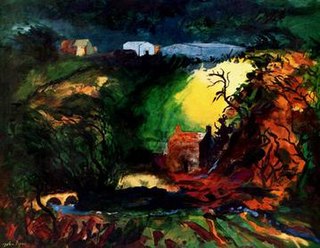
John Egerton Christmas Piper CH was an English painter, printmaker and designer of stained-glass windows and both opera and theatre sets. His work often focused on the British landscape, especially churches and monuments, and included tapestry designs, book jackets, screen-prints, photography, fabrics and ceramics. He was educated at Epsom College and trained at the Richmond School of Art followed by the Royal College of Art in London. He turned from abstraction early in his career, concentrating on a more naturalistic but distinctive approach, but often worked in several different styles throughout his career.

Bernard Hailstone was an English painter, best known for his Second World War portraits of transport and civil defence workers painted in Britain, his portraits of members of the Armed Forces painted overseas and his post-war portraits of the royal family, musicians, stage and film actors.

The Lowry is a theatre and gallery complex at Salford Quays, Salford, Greater Manchester, England. It is named after the early 20th-century painter L. S. Lowry, known for his paintings of industrial scenes in North West England. The complex opened on 28 April 2000 and was officially opened on 12 October 2000 by Queen Elizabeth II.
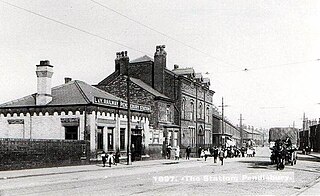
Pendlebury railway station was a station serving the town of Pendlebury in the City of Salford, Greater Manchester, England. It was closed in 1960 by British Railways.

Harold Francis Riley, DL was an English artist. He sold his first painting to the Salford Museum and Art Gallery when he was 11.
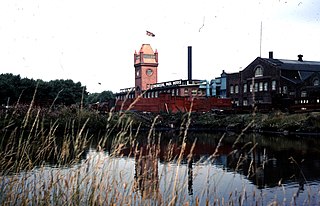
Mather & Platt is the name of several large engineering firms in Europe, South Africa and Asia that are subsidiaries of Wilo SE, Germany or were founded by former employees. The original company was founded in the Newton Heath area of Manchester, England, where it was a major employer. That firm continues as a food processing and packaging business, trading as M & P Engineering in Trafford Park, Manchester.
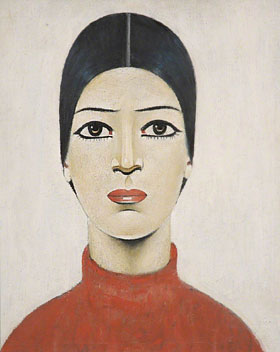
Portrait of Ann (1957) is a painting by British artist L. S. Lowry (1887–1976). Opinion remains divided as to the identity of the subject, who appears in many of Lowry's works, and her significance for the artist.
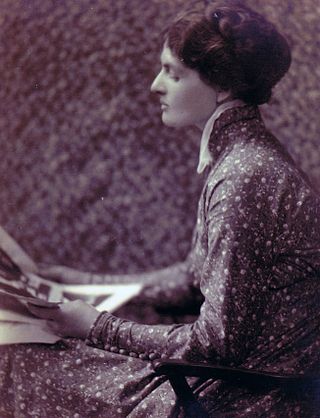
Ethel Léontine Gabain, later Ethel Copley, was a French-Scottish artist. Gabain was a renowned painter and lithographer and among the founding members of the Senefelder Club. While she was known for her oil portraits of actresses, Gabain was one of the few artists of her time able to live on the sale of her lithographs. She also did etchings, dry-points, as well as some posters.
Roland Vivian Pitchforth RA ARWS was an English painter, teacher and an official British war artist during the Second World War. He excelled at watercolours and in later years concentrated on landscapes, seascapes and paintings of atmospheric effects.
The War Artists' Advisory Committee (WAAC), was a British government agency established within the Ministry of Information at the outbreak of the Second World War in 1939 and headed by Sir Kenneth Clark. Its aim was to compile a comprehensive artistic record of Britain throughout the war. This was achieved both by appointing official war artists, on full-time or temporary contracts and by acquiring artworks from other artists. When the committee was dissolved in December 1945 its collection consisted of 5,570 works of art produced by over four hundred artists. This collection was then distributed to museums and institutions in Britain and around the world, with over half of the collection, some 3,000 works, going to the Imperial War Museum.
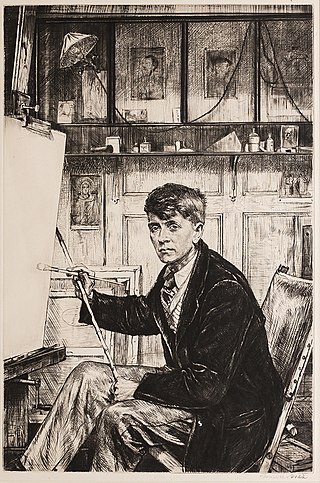
Charles Ernest Cundall,, , was an English painter of topographical subjects and townscapes, best known for his large panoramic canvases.
Frances Macdonald, was an English painter known for her panoramic scenes painted in Wales, the south of France and in London during World War II.

Ruby Loftus Screwing a Breech-ring is a 1943 painting by the British artist Laura Knight depicting a young woman, Ruby Loftus, working at an industrial lathe cutting the screw of a breech-ring for a Bofors anti-aircraft gun. The painting was commissioned by the War Artists' Advisory Committee as part of the British war effort in the Second World War.

Coming from the Mill is an oil-on-canvas painting created in 1930 by British painter Laurence Stephen Lowry.
Kathleen Saywell Allen (1906–1983) was a British painter, muralist, designer and art teacher. Allen is known for her urban landscapes and, in particular, scenes depicting post-war rebuilding in London.
Rose Louise Henriques, Lady Henriques was a British artist and social and charity worker in the East End of London, where she was born and lived throughout her life. She was posthumously recognised as a British Hero of the Holocaust.
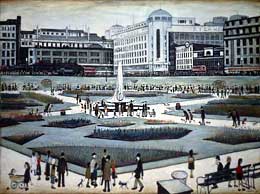
Piccadilly Gardens is a 1954 oil painting by the English artist L. S. Lowry. It depicts Piccadilly Gardens, a large garden square in Manchester city centre, north-west England. The painting hangs in the Manchester Art Gallery on nearby Mosley Street.
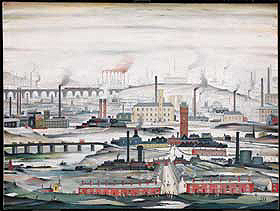
Industrial Landscape is the title given to each of a series of oil paintings by the English artist L. S. Lowry, painted over a number of years between 1934 and 1955.
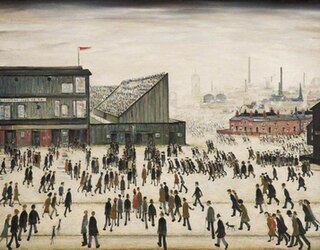
Going to the Match is a painting by British painter L. S. Lowry from 1953, depicting football fans and Burnden Park, the then home of Bolton Wanderers Football Club. Lowry had previously painted a different Going to the Match in 1928, which depicted fans outside a rugby ground, however, the 1953 painting has gained more fame over the years and become synonymous with the phrase Going to the Match. The 1953 picture sold at auction for £7.8 million in 2022, whereas the 1928 painting was valued at between £2 and £3 million in 2021.



















